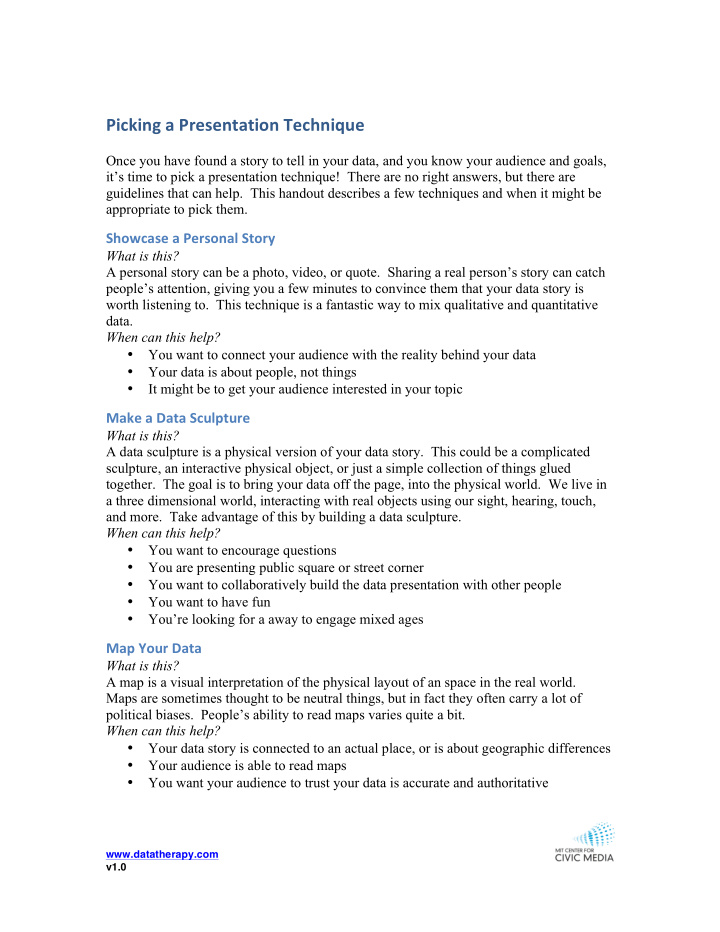



Picking ¡a ¡Presentation ¡Technique ¡ Once you have found a story to tell in your data, and you know your audience and goals, it’s time to pick a presentation technique! There are no right answers, but there are guidelines that can help. This handout describes a few techniques and when it might be appropriate to pick them. Showcase ¡a ¡Personal ¡Story ¡ What is this? A personal story can be a photo, video, or quote. Sharing a real person’s story can catch people’s attention, giving you a few minutes to convince them that your data story is worth listening to. This technique is a fantastic way to mix qualitative and quantitative data. When can this help? • You want to connect your audience with the reality behind your data • Your data is about people, not things • It might be to get your audience interested in your topic Make ¡a ¡Data ¡Sculpture ¡ What is this? A data sculpture is a physical version of your data story. This could be a complicated sculpture, an interactive physical object, or just a simple collection of things glued together. The goal is to bring your data off the page, into the physical world. We live in a three dimensional world, interacting with real objects using our sight, hearing, touch, and more. Take advantage of this by building a data sculpture. When can this help? • You want to encourage questions • You are presenting public square or street corner • You want to collaboratively build the data presentation with other people • You want to have fun • You’re looking for a away to engage mixed ages Map ¡Your ¡Data ¡ What is this? A map is a visual interpretation of the physical layout of an space in the real world. Maps are sometimes thought to be neutral things, but in fact they often carry a lot of political biases. People’s ability to read maps varies quite a bit. When can this help? • Your data story is connected to an actual place, or is about geographic differences • Your audience is able to read maps • You want your audience to trust your data is accurate and authoritative www.datatherapy.com v1.0
Make ¡a ¡Creative ¡Map ¡ A “creative map” uses the visual design elements of a map to make a less traditional representation of space. This can include things like leaving out some parts or changing the sizes of others. You can start with a real map, and then change some of the rules. When can this help? • You want to highlight a particular piece of data about the places • Your audience is interested enough to learn how to “read” your new map • You want to have some fun with an old technique • You want to encourage a discussion Chart ¡Your ¡Data ¡ What is this? Traditional charts include things like bar-charts, pie-charts, line-graphs and others. These designs have a long history and are taught in lots of school systems around the world. When can this help? • You are talking with your audience in a professional setting • You want your audience to assume you are right, rather than asking you questions • Your audience knows how to read traditional charts Make ¡a ¡Creative ¡Chart ¡ What is this? A “creative chart” uses the visual language of traditional charts in a new way. Traditional charts and graphs have established a vocabulary of design that many people know how to read. A slice of a pie-chart can still be understood without the rest of it. A single line going from left to right can still be read as a line graph without the axes, title, and other components. When can this help? • Your audience is interested enough in your topic already to learn how to read your new chart • You have a chance to walk your audience through how to read the chart • Your audience likes cool new ways to present stories • You want to have some fun Make ¡a ¡Real-‑World ¡Data ¡Game ¡ What is this? A real-world data game is about letting your audience represent the data with their bodies in some way. This could be as simple as raising their hands to show their point of view on a question, or it could involve them moving around and creating things. This is a fun, engaging way to present a data story that can be impactful. Letting people be the data connects them with the information in a real way. When can this help? • Your audience could be bored • You have a space your audience can move around in • You want to encourage questions and interaction with your audience www.datatherapy.com v1.0
www.datatherapy.com v1.0
Recommend
More recommend